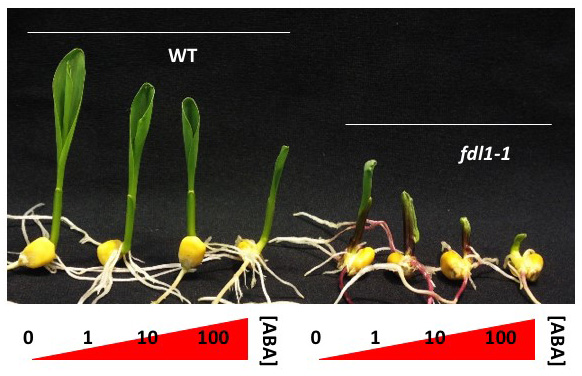THE IDENTIFICATION OF GENETIC-MOLECULAR MECHANISMS INVOLVED IN CUTICLE BIOSYNTHESIS IN MAIZE OPENS INTERESTING PERSPECTIVES FOR IMPROVING DROUGHT-STRESS TOLERANCE IN CROPS
In all terrestrial plants, the outer surface of the aerial parts is covered by the cuticle, a complex lipid layer that forms a barrier against damages caused by environmental factors and water loss. In this study we have shown that cuticle deposition during the juvenile phase of the maize plant is controlled by the transcription factor FUSED LEAVES 1 (FDL1), previously isolated in our laboratory. Genetic analysis, combined with transcriptome analysis, has also allowed the identification of other key genes involved in lipid metabolism.
In maize seedlings grown under water deficiency or treated with abscisic acid we observed a decrease in cuticle-mediated leaf permeability, and this decrease was related to changes in the transcript levels of FDL1 and associated genes.
Overall, our results demonstrate that the cuticle-mediated water stress response is an active response and implies a change at the transcriptional level in the activity of genes involved in wax biosynthesis. This activation is mediated by FDL1 and by the action of abscisic acid (ABA).
Figure. Representative images of maize seedlings treated with the abscisic acid hormone (ABA). Wild type (WT) maize seedlings are compared with loss-of-function mutants of the FDL1 gene (fdl1-1) grown for 48 hours with the root system immersed in solution at increasing ABA concentrations (0, 1, 10 and 100 µM).
Reference
Castorina, G., Domergue, F., Chiara, M., Zilio, M., Persico, M., Ricciardi, V., Horner, D., Consonni, G. (2020). Drought-responsive ZmFDL1/MYB94 regulates cuticle biosynthesis and cuticle-dependent leaf permeability. Plant Physiology, 184(1), 266-282.
DOI: https://doi.org/10.1104/pp.20.00322

